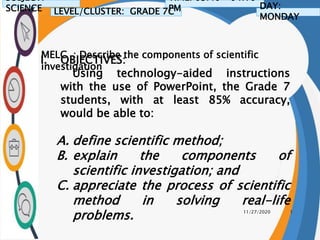
SCIENCE7: Components of Scientific Investigation
- 1. 11/27/2020 1 I. OBJECTIVES: Using technology-aided instructions with the use of PowerPoint, the Grade 7 students, with at least 85% accuracy, would be able to: A. define scientific method; B. explain the components of scientific investigation; and C. appreciate the process of scientific method in solving real-life problems. SUBJECT: SCIENCE LEVEL/CLUSTER: GRADE 7C TIME: 03:40 – 04:10 PM DAY: MONDAY MELC : Describe the components of scientific investigation
- 2. How do you show the process of solving problems?
- 3. Science comes from Greek word ‘scientia’ which means ‘knowledge’. It is an systematic body of knowledge. TERMS TO REMEMBER… Scientif ic Method is the systematic way of solving problems. Hypothes is is the an educated guess. It needs further investigation. Theory is a well-tested hypothesis.
- 4. 6 Steps – Scientific Method Make an observation Observation is the process of employing our senses. Exampl e: Let's suppose that you get two slices of bread, put them into the toaster, and press the button. However, your bread does not toast.
- 5. 6 Steps – Scientific Method Identify the problemScientific problems are usually based on observation of scientific phenomena.Exampl e: Why didn't my bread get toasted?
- 6. 6 Steps – Scientific Method Formulate a hypothesisHypothesis is an educated guess. It must be testable and falsifiable in order to be valid.Exampl e: Our hypothesis in this case could be that the toast didn't toast because the electrical outlet is broken.
- 7. 6 Steps – Scientific Method Conduct ExperimentationExperiment is a procedure carried out to support, refute, or validate a hypothesis.Exampl e: In this case, we might predict that if the electrical outlet is broken, then plugging the toaster into a different outlet should fix the problem.
- 8. 6 Steps – Scientific Method Record and analyze dataData defined as information collected using specific methods for a specific purpose of studying or analyzing. Exampl e: For instance, in this case, we would plug the toaster into a different outlet and see if it toasts.
- 9. 6 Steps – Scientific Method Draw conclusions. Conclusions summarizes how your results support or contradict your original hypothesis: Exampl e: Reflect on our results and use them to guide our next steps.
- 10. 1. Why do we need to follow procedures in doing experimentation? ESSENTIAL QUESTIONS: 2. How does stating conclusions cite a very important part in solving problems? 3. What makes scientific method more accurate and valid way to solve problems? Explain. 4. How will you give emphasis on the importance of scientific method in our daily life?
- 11. LET’S WRAP IT UP! I. MULTIPLE CHOICE: Write only the letter of the correct answer. 1. It is the systematic way of solving problems. a. Hypothe sis b. Dat a c. Conclusi ons d. Scientific method2. This scientific method cites the stating of results done during the experimentation.a. Hypothe sis b. Dat a c. Conclusi ons d. Scientific method3. It is the process of employing different senses before collecting data.a. Analyze data b. Observat ion c. Experiment ation d. Science 4. It must be testable and falsifiable in order to be valid. a. Hypothesis b. Conclusi ons c. Theory d. Problems 5. It is defined as information collected using specific methods for a specific purpose of studying or analyzing.a. Hypothe sis b. Dat a c. Conclusi ons d. Scientific method II. SEQUENCING: Identify what steps of scientific method is best suited to the following pictures given below. 5. Analyze data 1. Make an observatio n 3. Formulate a hypothesis 4. Conduct experimentati on 2. Identify the problem 6. Draw conclusion
- 12. LET’S DEEPEN MORE : September 7, 2020 Using Google Forms, the teacher will post an assessment activity to the students to deepen their understanding and how they achieve the mastery level of the topic. The link of the assessment activity will be sent right after the session through class Group Chat in Messenger and/or in Google Classroom that is more accessible to the students to access with. NOTE: The assessment activity will be randomized. September 07, 2020 In a Google classroom, cite at least one observation/real-problems occur either in environment or in personal life and will use the scientific method on how they solved it. Submit it on Wednesday, September 9, 2020 @ 02:00 PM using .jpg format and or send to my email using .doc format at slagradeict2020@gmail.com. To know more about our topic, please click this link: https://www.youtube.com/watch?v=yi0hwFDQTSQ Sir Christian LET’S BRING IT HOME:
- 13. MODULAR: MODULAR: I. Write your answer in a short bondpaper. 1. Put the following steps in order, please number 1‐6. _______Hypothesis _______ Draw Conclusion _______ Experiment _______ Ask a Question _______ Analyze data _______ Collect Observations 2. Put the following steps of scientific inquiry in order, please number 1‐3. _______Make an observation _______ Ask a question _______ Form a hypothesis 3. Determine if each statement is true or false about forming a hypothesis: ____________ a. It must be long. ____________ b. It is an educated guess. ____________ c. It is in if…then format. ____________ d. It must be testable. ____________ e. It must start with I think 4. Make an observation in growing a plant A, B, C. A has more water and sunlight, B has more water and less sunlight and C has less water and more sunlight. Which of the plants would grow fastest? faster? slow? Cite your evidences in a short bondpaper.
